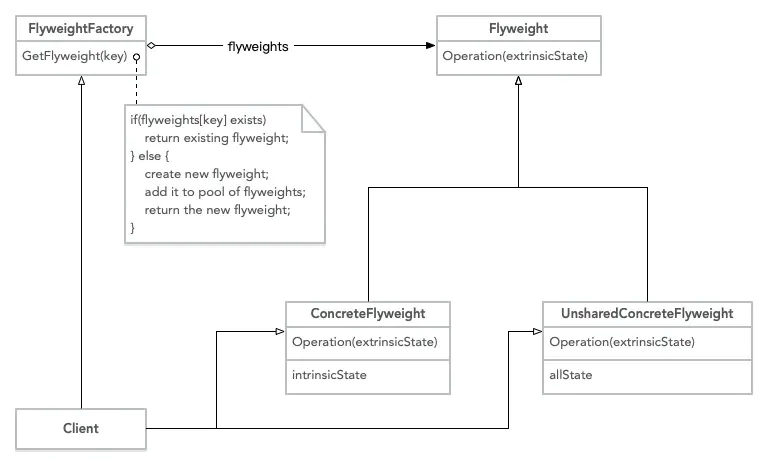
In the previous article "Talk about the proxy mode in PHP (forward proxy and reverse proxy)" we introduced the proxy mode in PHP. This article will take you to understand PHP Flyweight pattern in design patterns.

Flyweight mode, the word "flyweight" actually has no special meaning in Chinese, so we have to break it down and look at it. "Xiang" means sharing, and "Yuan" means elements. It seems easy to understand, sharing certain elements.
GoF definition: Use sharing technology to effectively support a large number of fine-grained objects
GoF Class Diagram

Code Implementation
interface Flyweight
{
public function operation($extrinsicState) : void;
}
class ConcreteFlyweight implements Flyweight
{
private $intrinsicState = 101;
function operation($extrinsicState) : void
{
echo '共享享元对象' . ($extrinsicState + $this->intrinsicState) . PHP_EOL;
}
}
class UnsharedConcreteFlyweight implements Flyweight
{
private $allState = 1000;
public function operation($extrinsicState) : void
{
echo '非共享享元对象:' . ($extrinsicState + $this->allState) . PHP_EOL;
}
}Define the shared interface and its Implementation, note that there are two implementations here, ConcreteFlyweigh shares state, UnsharedConcreteFlyweight does not share or its state does not need to be shared
class FlyweightFactory
{
private $flyweights = [];
public function getFlyweight($key) : Flyweight
{
if (!array_key_exists($key, $this->flyweights)) {
$this->flyweights[$key] = new ConcreteFlyweight();
}
return $this->flyweights[$key];
}
}Save the objects that need to be shared and use it as a factory to create the required shares Object, ensuring that there will only be a unique object under the same key value, saving the cost of creating the same object
$factory = new FlyweightFactory(); $extrinsicState = 100; $flA = $factory->getFlyweight('a'); $flA->operation(--$extrinsicState); $flB = $factory->getFlyweight('b'); $flB->operation(--$extrinsicState); $flC = $factory->getFlyweight('c'); $flC->operation(--$extrinsicState); $flD = new UnsharedConcreteFlyweight(); $flD->operation(--$extrinsicState);
The client's call allows the external state $extrinsicState to be shared between each object
Let’s talk about the fact that technology is based on changing its shell. After all, everyone still likes mobile phones in various colors to show their personality. As I said before, if we had to build a production line for each color, wouldn’t it be a huge investment? Fortunately, our factory (Xiangyuan Factory) only produces the most basic background shell (object) for each model, and then it is colored through a special printing line (state change)! Well, the next Iphone will imitate us sooner or later. It seems that we have to collect all kinds of gold and various rich colors first. Maybe we can also summon the dragon! !
Full code: https://github.com/zhangyue0503/designpatterns-php/blob/master/13.flyweights/source/flyweights.php
As expected, we still send text messages. This time the text messages are still sent using Alibaba Cloud and Jiguang SMS, but this time we use flyweight mode. Implementation, in the flyweight factory here we save two different types of objects, let's make them ever-changing through internal and external states!
SMS sending class diagram

Full source code: https://github.com/zhangyue0503/designpatterns-php /blob/master/13.flyweights/source/flyweights-message.php
<?php
interface Message
{
public function send(User $user);
}
class AliYunMessage implements Message
{
private $template;
public function __construct($template)
{
$this->template = $template;
}
public function send(User $user)
{
echo '使用阿里云短信向' . $user->GetName() . '发送:';
echo $this->template->GetTemplate(), PHP_EOL;
}
}
class JiGuangMessage implements Message
{
private $template;
public function __construct($template)
{
$this->template = $template;
}
public function send(User $user)
{
echo '使用极光短信向' . $user->GetName() . '发送:';
echo $this->template->GetTemplate(), PHP_EOL;
}
}
class MessageFactory
{
private $messages = [];
public function GetMessage(Template $template, $type = 'ali')
{
$key = md5($template->GetTemplate() . $type);
if (!key_exists($key, $this->messages)) {
if ($type == 'ali') {
$this->messages[$key] = new AliYunMessage($template);
} else {
$this->messages[$key] = new JiGuangMessage($template);
}
}
return $this->messages[$key];
}
public function GetMessageCount()
{
echo count($this->messages);
}
}
class User
{
public $name;
public function GetName()
{
return $this->name;
}
}
class Template
{
public $template;
public function GetTemplate()
{
return $this->template;
}
}
// 内部状态
$t1 = new Template();
$t1->template = '模板1,不错哟!';
$t2 = new Template();
$t2->template = '模板2,还好啦!';
// 外部状态
$u1 = new User();
$u1->name = '张三';
$u2 = new User();
$u2->name = '李四';
$u3 = new User();
$u3->name = '王五';
$u4 = new User();
$u4->name = '赵六';
$u5 = new User();
$u5->name = '田七';
// 享元工厂
$factory = new MessageFactory();
// 阿里云发送
$m1 = $factory->GetMessage($t1);
$m1->send($u1);
$m2 = $factory->GetMessage($t1);
$m2->send($u2);
echo $factory->GetMessageCount(), PHP_EOL; // 1
$m3 = $factory->GetMessage($t2);
$m3->send($u2);
$m4 = $factory->GetMessage($t2);
$m4->send($u3);
echo $factory->GetMessageCount(), PHP_EOL; // 2
$m5 = $factory->GetMessage($t1);
$m5->send($u4);
$m6 = $factory->GetMessage($t2);
$m6->send($u5);
echo $factory->GetMessageCount(), PHP_EOL; // 2
// 加入极光
$m1 = $factory->GetMessage($t1, 'jg');
$m1->send($u1);
$m2 = $factory->GetMessage($t1);
$m2->send($u2);
echo $factory->GetMessageCount(), PHP_EOL; // 3
$m3 = $factory->GetMessage($t2);
$m3->send($u2);
$m4 = $factory->GetMessage($t2, 'jg');
$m4->send($u3);
echo $factory->GetMessageCount(), PHP_EOL; // 4
$m5 = $factory->GetMessage($t1, 'jg');
$m5->send($u4);
$m6 = $factory->GetMessage($t2, 'jg');
$m6->send($u5);
echo $factory->GetMessageCount(), PHP_EOL; // 4Description
Original address: https://juejin.cn /post/6844903965814259726
Author: Hardcore Project Manager
Recommended learning: "PHP Video Tutorial"
The above is the detailed content of Learn about the flyweight pattern in PHP in one article. For more information, please follow other related articles on the PHP Chinese website!